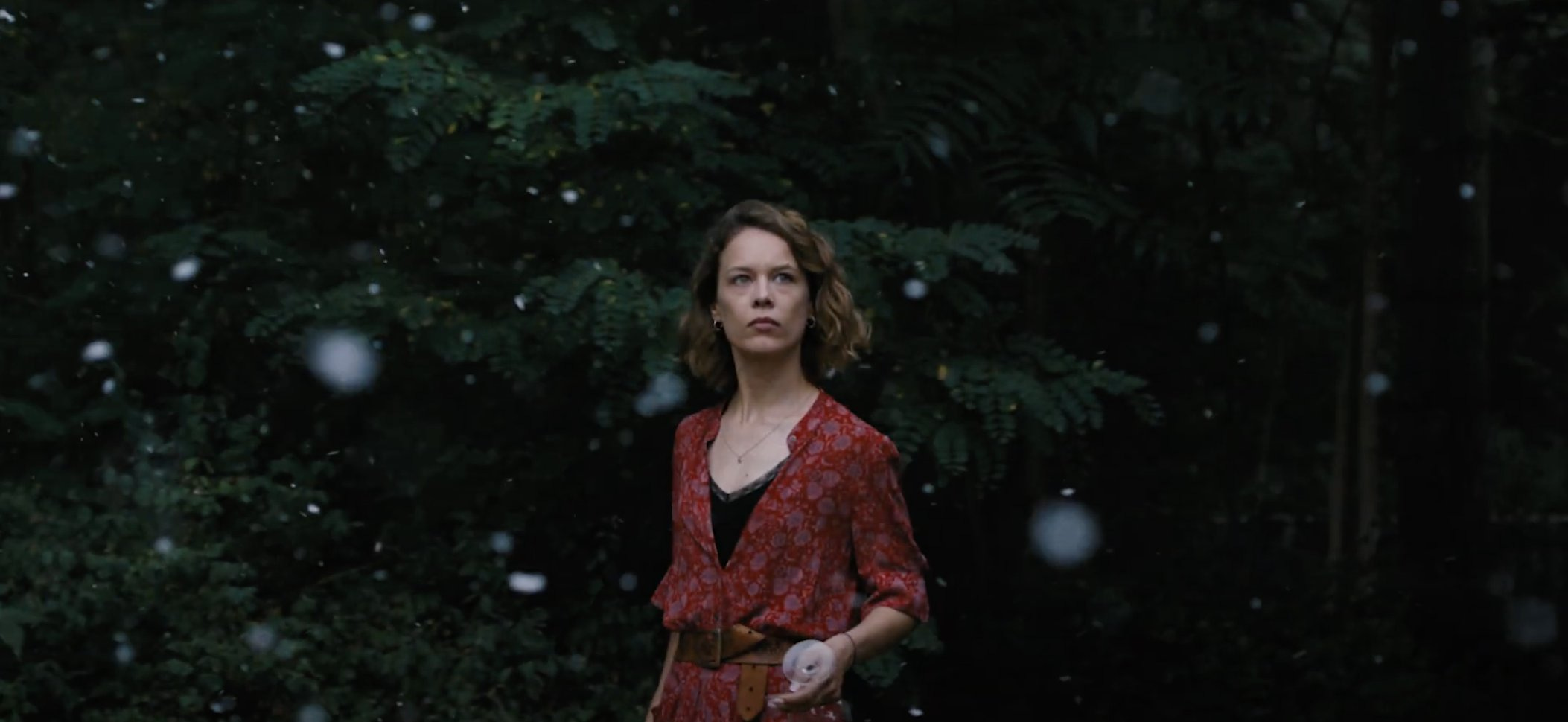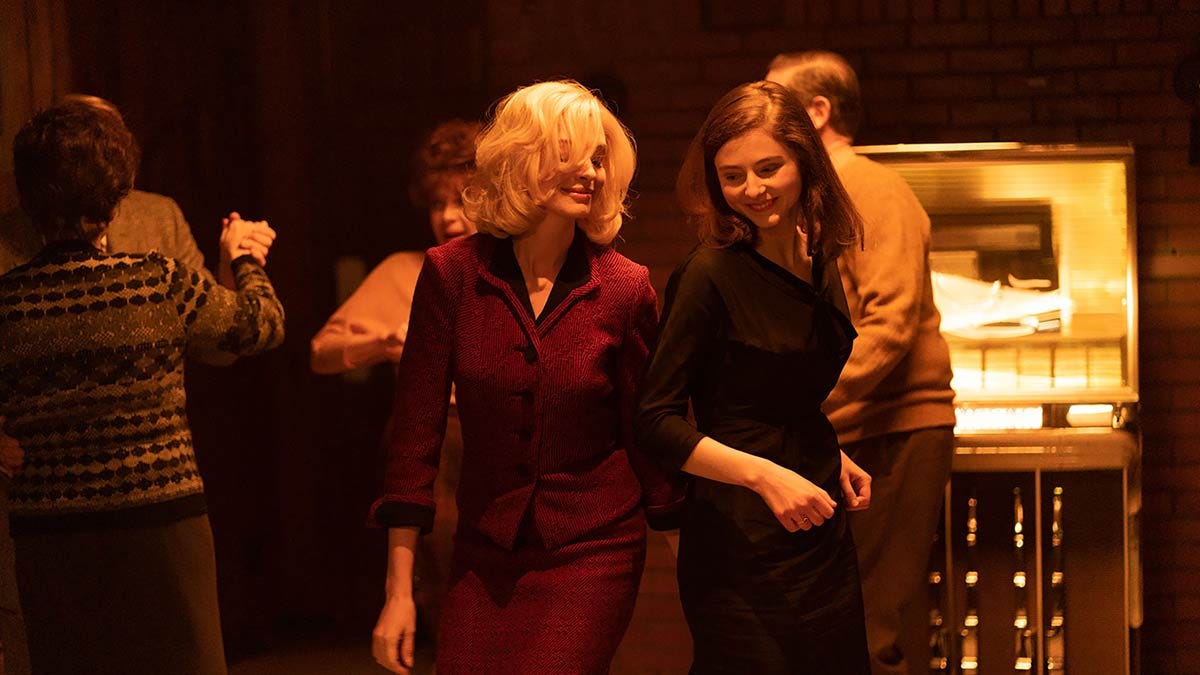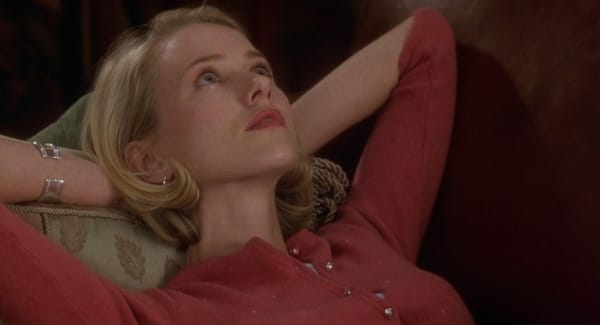What to Watch: "'Burn" After Seeing
Reviews of "Saltburn" and "Eileen" in theaters; "Afire" plus two rock documentaries on demand.

On Demand: Todd Haynes’ exquisitely unnerving “May December” arrives on Netflix today, fast on the heels of its theatrical release. My ⭐ ⭐ ⭐ 1/2 review from two weeks back is here.

The German writer-director Christian Petzold has slowly and quietly been building one of the more impressive filmographies around – tricky moral tales that weave in and out of genres like suspense (“Barbara,” 2012), melodrama (“Phoenix,” 2014), romance (“Transit,” 2019), and fantasy (“Undine,” 2020) while never losing their grip as implied or explicit political statements. “Afire” (⭐ ⭐ ⭐, 2023, streaming on the Criterion Channel) appears to be one of Petzold’s more low-key outings: It takes place in the present day (as opposed to a war-torn or paranoid past), among doctoral students on vacation, and much of the film is made up of conversations about literature and sex. In short, it could be an Eric Rohmer movie that escaped from the 1970s. True, there’s a wildfire that is consuming the nearby countryside, but it stays mostly over the horizon. Mostly.
Every party has a pooper, though, and that’s why Petzold has invited Leon (Thomas Schubert), a human black cloud who’s in a funk about his second novel, which he’s just finished and which he knows is dreadful. Leon and his more cheerful photographer friend Felix (Langston Uibel) arrive at the latter’s mother’s vacation cottage only to find that it’s already being rented by Nadja (Paula Beer), a free spirit whose noisy lovemaking with a local lifeguard (Enno Trebs) serves to further sour Leon’s already pickled mood. “Afire” settles into a gently satirical character study of a pompous young academic who’s his own worst enemy, and Schubert is a skilled enough actor to make Leon simultaneously sympathetic and unbearable. (Beer is the definition of screen charisma, but her character – a grounded gamine – never quite makes sense, and “Afire” suffers for it.)
As with Rohmer, the lightness of the film’s surface glides us noiselessly out of the characters’ depths and our own. There is an eventual tragedy, and the sound of a heart breaking, and the sense that art isn’t a retreat from human suffering and the world’s blind chaos but only a way to try to make sense of them, if only by pushing the pieces around on paper. Or perhaps simply bearing witness. “Afire,” after the watery ”Undine” the second in a planned “elements” tetralogy, ends with a coda that feels rather too neatly resolved, and maybe that’s all it is. But Petzold is one of the last filmmakers I’d expect to believe in tidy endings. He knows the wildfires are almost here.

“In the Court of the Crimson King: King Crimson at 50” (⭐ ⭐ ⭐, available for rental on Amazon). I’d normally recommend a rock documentary primarily to its fans, but even if you’ve never heard of King Crimson, there are rewards here in dry English humor, a recognition of human loss, a valuing of perfectionism as the highest ideal in musicmaking, and an understanding of how annoying that perfectionism can be when applied to other people. Or, to put it another way: Why Robert Fripp is the most maddening of polite English geniuses.
As bandleader, solo artist, sideman, producer, gadfly, and master guitarist, Fripp has been a constant in the British music scene – art-rock/prog-rock/math-rock/noise-rock divisions – for over half a century, ever since “20th Century Schizoid Man” stormed out of dorm room stereo speakers in 1969. He’s been allied with Bowie and Brian Eno, among many others and his unique guitar sound, a kind of electrified neon blue, is the rock equivalent of a lightsabre and has popped up in the most unlikely places (like The Roches’ “Hammond Song,” which Fripp also produced).
But King Crimson has been his main order of business, or, rather, the many iterations of Crimson of which Fripp has been the one constant, an eccentric professor in a three-piece suit (in the 1970s!) demanding that his bandmates execute complex algebraic calculations in their heads if they want to keep up with the music.
Some have fallen by the wayside, some are in it for the long haul, and some are exiled from the kingdom for reasons they’ll never understand. Directed by Toby Amies, “In the Court of the Crimson King” is most entertaining when the many, many Crimson musicans over the years testify to the Challenge of Working With Robert, including the band’s co-founder Ian McDonald, who bailed after the first album and who offers a heartfelt if belated apology to Fripp here). Guitarist Adrian Belew, a mainstay of the anarchofunk-minimalist ‘80s Crimson, is still smarting from learning he was no longer in the band by reading about it in a music magazine. And one of the latest band’s three drummers, Bill Rieflin, stays on the road with Fripp despite struggling with Stage 4 cancer, noting with mordant and moving humor that the boss man’s demands are a way of living life and art to their fullest in the limited time the drummer has left. (Rieflin died after filming was completed in 2020.)
The man at the center of all this palaver cuts a touching figure, a natty, white-haired monk of music who still feels that any day without four hours of guitar practice has to be deemed a catastrophe. The rewards for putting himself and his bandmates on the rack of difficult time signatures are many, including a fanbase that stretches across a half century (and which numbers at least one very devoted, very cogent Catholic nun) and the songs themselves – knotty, adventurous, and requiring a discipline that is almost, but not quite, the point. This documentary is one of those rewards, too: A paean to the pains and ecstasies of extreme music-making.

By contrast, “The Stones and Brian Jones” (⭐ ⭐ 1/2, available for rent on Amazon, Apple TV, YouTube, and elsewhere) is for fans only, or for Stones neophytes who don’t already know the sad story of how a mercurial middle-class blues freak named Brian started a rock and roll band only to see it taken away from him by the group’s singer and lead guitarist. The way longtime rock-doc filmmaker Nick Broomfield tells it, Jones was doomed by his crippling insecurity, parental disapproval, and lack of songwriting ability, but through the cracks of the interviews with the many mothers of Brian’s many abandoned children, you can glimpse a young man who was simply not very good at living life. The film is worth a Stones die-hard’s time for the early concert footage and for the participation of a pleasantly doddering Bill Wyman; Mick and Keith are present on the soundtrack in archival interviews, sounding vaguely but not definitively guilty for throwing their bandmate under the bus. But only ex-girlfriend Zouzou, a one-time French pop star now gravel-voiced, elderly, and very funny, has the proper long-distance sympathy for this minor-league devil.

Oh, “Saltburn” (⭐ ⭐, in theaters), I wish I loved you as much as some of my friends and relations do. The second film written and directed by Emerald Fennell – after the similarly polarizing “Promising Young Woman” (2020) – is a stylish, heavy-handed drama of class resentments and comeuppance, with a slippery Barry Keoghan (“The Banshees of Inisherin”) cast as Oliver Quick, a lower-middle-class nobody at Oxford who weasels his way into the aristocratic family of a classmate (Jacob Elordi of “Euphoria” and “Priscilla”). There are scenes in “Saltburn” calculated to shock – Oliver slurping the bathtub leftovers of his social betters, a seduction of the classmate’s sister (Alison Oliver) that gives new meaning to the phrase “period piece” – but it’s that calculation that lodges in the craw, the sense (as in “Promising Young Woman”) that Fennell prizes giving her bourgeoise audiences a “daring” hotfoot more than narrative coherence or coherent atmosphere. So the big reveal at the end of the new movie reveals very little, since “Saltburn” has tipped its hand about Oliver from the moment he shows up at the vast country estate of the title (Drayton House in Northamptonshire, if you’re looking for an AirBnB).
Maybe it’s a factor of age or a life spent wallowing in popular culture, but as I watched “Saltburn,” my mind kept returning to earlier and better versions of this class-war fairy tale. “The Talented Mr. Ripley,” for one – either the Patricia Highsmith novel or the Anthony Minghella/Matt Damon movie or both. Mervyn Peake’s truly mad “Gormenghast” books and the 2000 BBC/PBS series made from them. (A new version is in the works, with Neil Gaiman and Akiva Goldsman on board as producers.) The narrative red thread that connects all these stories is that of a crafty, amoral sociopath inveigling his way into a cloistered nobility that, through their wealth and general cluelessness, is just asking to be fleeced. (Bong Joon-ho’s “Parasite” is a variation on similar themes.) We’re meant to have our loyalties split between the proletariat interloper and the upper-class twits, and “Saltburn” keeps that compact until the final act, when it takes its stand with the poor, abused aristos against the nasty upstarts. There’s fertile ground for satire here, but that would require a scalpel, and Fennell wields a blunt hatchet.
Well, at least Keoghan gets a lead role out of it, one that carries echoes of his malefic turn in “The Killing of a Sacred Deer” (quite literally in one party scene), and there are good performances by Elordi, Oliver, Rosamund Pike as the castle matriarch, Richard E. Grant as her husband, and, in and out of the movie in a sloe-eyed flash, Carey Mulligan playing “Poor, Dear Pamela,” as the credits put it – possibly the best joke in the movie.
Two final thoughts. First, looking at Keoghan, I see an actor preparing for a long and high-wire career (and also an uncanny likeness to the young Ian McKellen). There are worse cart tracks to follow. Second, if any young viewer is prompted by “Saltburn” to visit Richard E. Grant’s majestic star-making debut performance in 1987’s “Withnail & I,” then it will all turn out to have been worthwhile.

Speaking of Highsmith, when I reviewed “Eileen” (⭐ ⭐ ⭐ 1/2, in theaters) at Sundance in January, I suggested that “it plays like [Todd Haynes’] ‘Carol’ if one of the characters turned out to be Tom Ripley.” A comparison with “Saltburn” is instructive: Both films provoke more than convince, but, as directed by William Oldroyd (“Lady Macbeth”) and scripted by Otessa Moshfegh from her 2013 novel, “Eileen” messes with an audience’s head in stranger, funnier, and less predictable ways. It’s more genuinely uncomfortable than Fennell’s movie and, for that reason, closer to the bone of what both are aiming for. From my review: “At first, you think you’re getting a prototypical Sundance movie about small-town wasted lives: Mousy young Eileen (Thomasin McKenzie of ‘Leave No Trace’ and ‘Last Night in Soho’) lives in a wintry mid-1960s New England town with an alcoholic wreck of a father (Shea Whigham – who else?) and works as a secretary at the local juvenile prison. With the arrival of a new prison psychologist, the glamorous, blonde, and seductive Dr. Rebecca St. John (Anne Hathaway), the movie gets a little bit ‘Marnie’ and a little bit ‘Carol,’ and then things actually start getting weird. The fine stage actress Marin Ireland gets off an unnerving monologue while her character is tied to a post in a basement, and both Mackenzie and Hathaway are at the top of their games here, the former playing deceptively meek and the latter deceptively wild… Bonus points for dialogue that precisely captures the bred-in-the-bone bleakness of the native New Englander (‘You look happy – what’s wrong with you?’) and for a shooting gallery of Boston accents that mostly hit their marks.”
Comments? Please don’t hesitate to weigh in.
If you enjoyed this edition of Ty Burr’s Watch List, feel free to pass it along to others.
If you’re not a paying subscriber and would like to sign up for additional postings and to join the discussions — or just help underwrite this enterprise, for which the author would be eternally grateful — here’s how.
You can give a paid Watch List gift subscription to your movie-mad friends —
Or refer friends to the Watch List and get credit for new subscribers. When you use the referral link below, or the “Share” button on any post, you'll:
- Get a 1 month comp for 3 referrals
- Get a 3 month comp for 5 referrals
- Get a 6 month comp for 25 referrals. Simply send the link in a text, email, or share it on social media with friends.
There’s a leaderboard where you can track your shares. To learn more, check out Substack’s FAQ.





